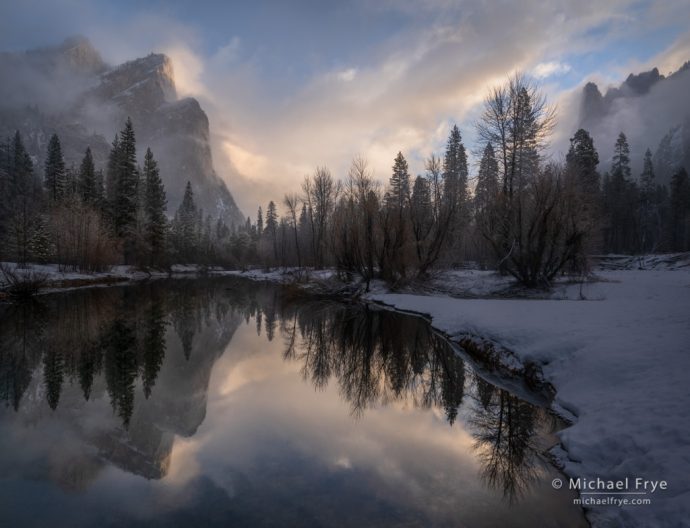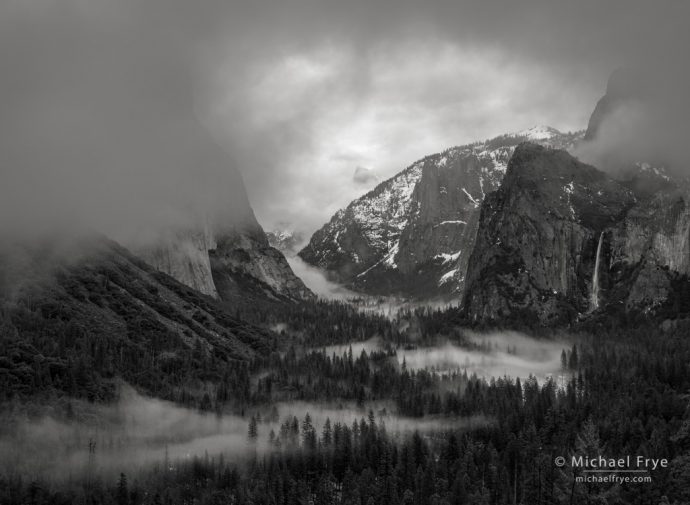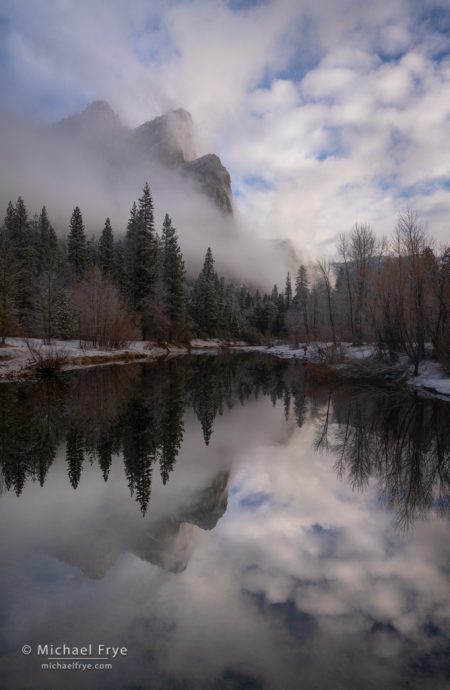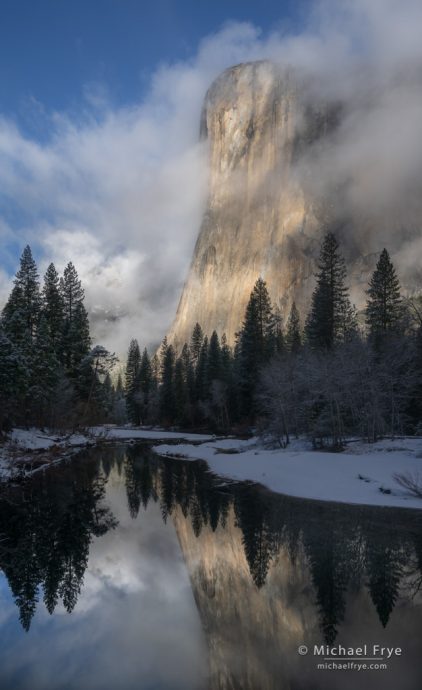
Three Brothers, Sentinel Rock, and the Merced River at sunrise, Yosemite. On Saturday morning the sun broke through the clouds just after sunrise to light the Three Brothers. 19mm, 1/20 sec. at f/11, ISO 100.
Aside from one big storm in late January, it’s been another dry winter here in central California. So any forecast for precipitation – even a small amount – piques my interest.
On Monday Yosemite Valley got two-tenths of an inch of rain, then another two-tenths early Saturday morning. That’s pretty meager, and often such small storms don’t add enough moisture to the atmosphere to generate any mist. But surprisingly, both of these small systems created lots of mist in the valley.
Perhaps that’s because old snow, leftover from that late-January storm, still covers most of the valley floor. Snow-covered ground can help create mist by chilling the air near the surface to its dew point – especially if moisture gets added to the air by new precipitation, raising that dew point. Even a little bit of new precipitation is apparently enough to create lots of mist in the valley under the right conditions.
Monday afternoon, after that first little rainstorm, it looked like there was a small chance that the skies could clear and the sun might break through late in the afternoon, so Claudia and I headed up to the valley. Despite seeing patches of blue sky late in the day, the sun never did break through, but it was a good afternoon for capturing moody black-and-white scenes:

Mist and clouds from Tunnel View, Yosemite. The sun never broke through Monday afternoon, but abundant mist created some beautiful black-and-white scenes. 50mm, 1 sec. at f/11, ISO 100.
Saturday morning’s weak storm was predicted to be a little colder, so I thought there might be a chance for a dusting of snow on the valley floor. And all signs pointed to the storm (if it can be called that) clearing right around sunrise, which would be great timing. However, forecasts called for only two- to three-tenths of an inch of precipitation, and if we got less there wouldn’t be much chance of either mist or snow.
I got up at 4:15 Saturday morning and checked the weather. Radar images showed that precipitation had just started in Yosemite Valley, so it was hard to tell how much would fall. Temps were just above freezing, which might be cold enough for a little snow. It still looked liked the precipitation would end near sunrise – a quick-hitting little system. Chances for a great clearing storm seemed iffy, but since this would be the last precipitation of any kind for awhile, I decided to take a chance and drive up to Yosemite Valley.
Later I saw that the valley’s rain gauge showed 0.18 inches of precipitation for this storm. That was at the lower end of the forecasts, but apparently it was just enough. When I arrived I found plenty of mist, along with an inch of new snow etching the trees. And skies were showing signs of clearing.
I headed for a spot along the river with a view of Three Brothers. I was joined, eventually, by a number of other photographers – it was, after all, a Saturday during Horsetail Fall season – and was pleasantly surprised to run into our friends Beth Young and Chris Ring.
A lingering snow shower delayed the storm’s clearing slightly, but soon after sunrise the sun broke through, and we all got treated to a beautiful Yosemite clearing storm. The mist lingered, while the sun kept peaking through clouds, on and off, for a couple of hours, giving me time to capture a number of different compositions.
Photographically, the size of a storm is less important than its temperature and timing. This wasn’t much of a storm at all, but it was just wet enough, and cold enough, and it had impeccable timing.
— Michael Frye

Mist, clouds, and the Three Brothers, Yosemite. Saturday morning again; I loved the cloud-pattern and mist at this moment. 26mm, 1/125 sec. at f/11, ISO 100.

El Capitan during a clearing storm, Yosemite. After making the previous photo, I spotted sunlight breaking through on El Cap, and hurried over to compose this image. 26mm, 1/125 sec. at f/11, ISO 100.
Related Posts: Riding Out the Storms; Aftermath
Michael Frye is a professional photographer specializing in landscapes and nature. He is the author or principal photographer of The Photographer’s Guide to Yosemite, Yosemite Meditations, Yosemite Meditations for Women, Yosemite Meditations for Adventurers, and Digital Landscape Photography: In the Footsteps of Ansel Adams and the Great Masters. He has also written three eBooks: Light & Land: Landscapes in the Digital Darkroom, Exposure for Outdoor Photography, and Landscapes in Lightroom: The Essential Step-by-Step Guide. Michael has written numerous magazine articles on the art and technique of photography, and his images have been published in over thirty countries around the world. Michael has lived either in or near Yosemite National Park since 1983, currently residing just outside the park in Mariposa, California.









In your long exposures do you use the law of reciprocity ? Thanks in advance Michael..
Well yes, but I could say that I use the law of reciprocity for every photograph. I’m constantly doing quick calculations in my head, like, “I need to increase the shutter speed from 1/15 sec. to 1/125 sec. to freeze the motion of the subject here, and want to keep the aperture the same, so that means I need to push up the ISO three stops.” It took me longer to write that than to do it on my camera, since such calculations are instinctive at this point.
If you’re asking whether I calculate long exposures that way, I guess the answer would be sometimes, soft of. If, for example, I’m shooting at 1/15 sec. at f/16, ISO 100, and I want to know what ND filter would allow me to get the same exposure (same image brightness) with a 4-second shutter speed (at the same aperture and ISO), then I’d count the difference in stops between 1/15 sec. and 4 seconds, and that would tell me what ND filter I’d need. In that example it’s six stops, so I’d put on a six-stop ND filter. But once I have the filter on I’d confirm the exposure by using using the histogram, blinkies, and (on my Sony) zebras. In other words, I’m not totally relying on the law of reciprocity to get the right exposure; after all, what if the supposedly six-stop ND filter is actually seven stops, or five?